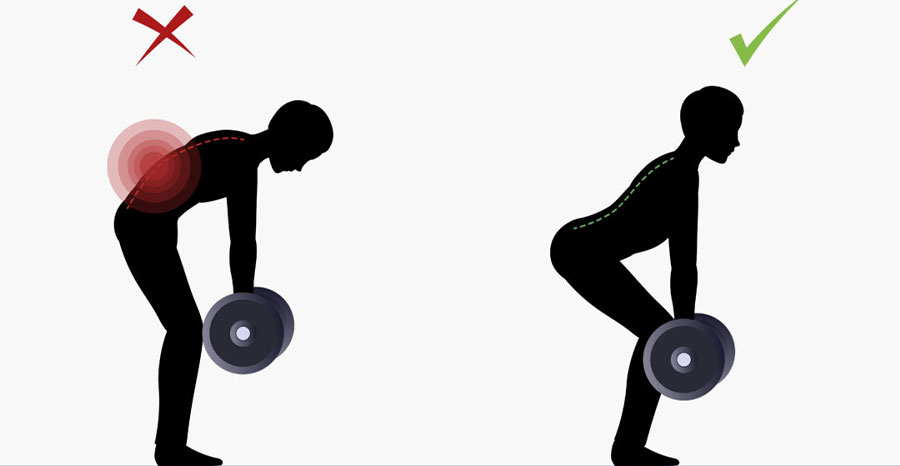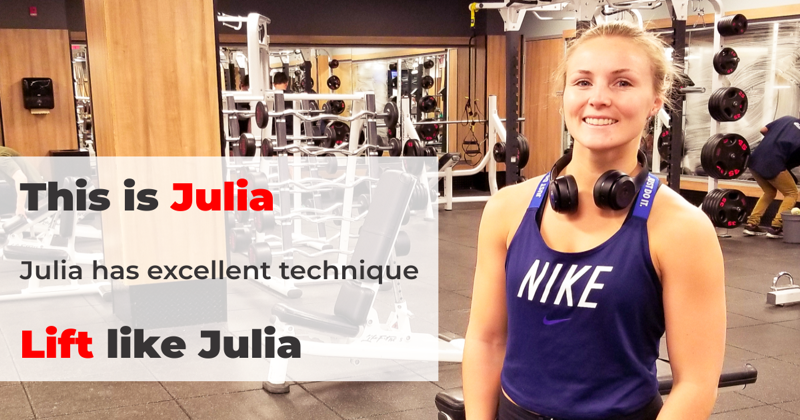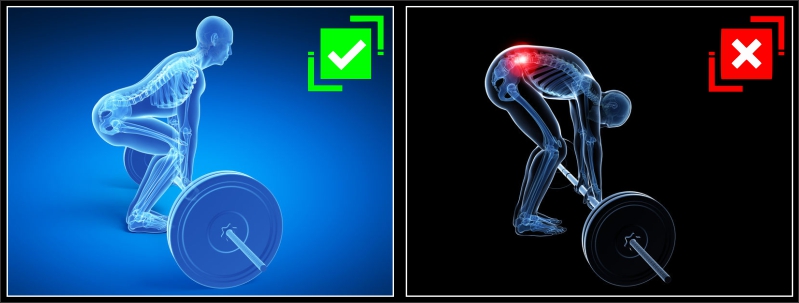
How to Lift Safely: Protecting Your Back
How to Lift Safely: Deadlift with Proper Form Protecting Your Back
You’re going along great on your training – gaining mass, getting stronger and leaner, and then it happens. An injury!
A simple muscle pull can mean weeks of recovery, and a tear or separation can require surgery and months of rehabilitation

In this post, we show you how to do the top 4 back-injury-inducing lifts correctly so this won’t happen to you. Knowing how to lift safely, and observing proper form every time, will lead to steady progress and a longer training lifetime.
Those injuries don’t just slow progress. They can lead to a permanently weakened muscle that you’ll have to baby for the rest of your heavy weight lifting career. If you want to make steady progress and build strength and body you’ve always wanted, it’s vital to avoid injury. Read our master guide “An Advanced Weight Training Workout for Building Mass and Strength“.
In this post, we’ll cover the four exercises most likely to result in severe injury to your lower back. Check back at the end of the month for the top 6 upper body exercises.
The Top 4 Back-Injury-Inducing Lifts – And How To Do Them Right!
Squats
There is no exercise that is more effective for building overall lower body strength. You’ll develop strong thighs and glutes, improve your balance and even gain some core strength. Unfortunately, if done wrong, you’ll quite likely end up with a serious injury.
Squats and deadlifts are the two exercises most likely to result in a severe back injury. It is vital to keep your back straight while doing squats. Keep your shoulders above your knees. Never bend forward – which will result in lifting with your back, not your legs! Top 6 Training Mistakes That Are Costing You Muscle.
Keep the motion slow and controlled. Don’t rest your weight on your knees at the bottom of the motion as this can result in injury to the ligaments in your knee joints.
Knees, once injured, may never be as strong again. So, it’s very important to protect them.
Deadlift
Probably the very best overall exercise you can do to get stronger. Deadlifts work pretty much every muscle in your body and lead to practical strength that you can use in everyday life.
Notice how Julia’s shoulders stay back on her knees. Her back is straight with a slight inner arch. The movement is smooth and controlled with no jerking of the weight at the start of each lift.
Pay close attention to the beginning of the lift and see how she is careful to drop her butt to take the weight with her legs, not her back.
Finally, at the top of the motion, tighten the glutes. This extra squeeze will not only help to strengthen those muscles but correct your posture at the top of each lift.
Benefits of Deadlifts Work – Deadlift Safely
I can tell you that the Deadlift is one of the best exercises you can do for overall strength and muscle development. And here’s why:
When you are doing Deadlift training, it works for several muscle groups. These muscle groups include your hips, back muscles, legs, and even your arms and grip strength. When you pull the weight off the ground, you are engaging a lot of different muscles at once. This makes the Deadlift setup a highly effective exercise.
The deadlift technique requires you to have good posture, with your hips pushed back and your chest lifted. This can help improve your posture and reduce the risk of injury.
When you deadlift, you are lifting a heavy weight from the ground. This requires a lot of strength and power, and as you get stronger, you will be able to lift heavier weights.
The heavy deadlift is pretty hard and you can’t deadlift properly if you are just starting out. Check out our blog “A Simple, Effective Training Program for Newbies“, if you are a beginner.
Proper Deadlift Form – Deadlifts Techniques
Foot Placement: Stand with your feet hip-width apart, pointing straight ahead. Place your weight evenly on both feet to ensure stability.
Stance Width: The width of your stance must be slightly wider than your hips.
The grip on the Barbell: Grip the barbell (or dumbbell) with your hands slightly wider than your hips. Your palms must be facing away from your body.
Knee and Hip Bend: Keeping your back straight, bend your knees to reach down and grab the bar.
Straight Back and Head Positioning: Lift the barbell off the ground, while keeping your back straight and your head facing forward. Your shoulders need to be directly over the barbell.
Lifting and Lowering the Barbell: Lift the weight bar off the floor up to your hips with a straight back, pause, then lower the bar back down to the ground. Push your feet through the floor and pull the bar up, keeping the bar close to your body. Repeat for the desired number of reps.
Common Barbell Deadlift Mistakes and How to Avoid Them
Rounding of the Lower Back
It is important to focus on keeping your back straight and your chest lifted throughout the entire repetition to avoid rounding your lower back and putting yourself at risk of injury.
Hyperextension of the Lower Back
Hyperextension of the lower back occurs when you arch your back too much, which puts excessive strain on your lower back. To avoid this, focus on maintaining a neutral spine and keeping your back straigh
Bending Forward at the Hips
Bending forward at the hips can also put unnecessary strain on your lower back. Focus on maintaining a straight upper back and lower back while keeping your shoulders directly over the barbell to lift the bar.
Improper Grip on the Barbell
An improper grip on the barbell can make it difficult to maintain proper form and increase your risk of injury. Make sure you grip the bar in a secure way and that your hands are slightly wider than your hips.
Lifting Too Much Weight
Lifting too much weight can compromise your form and increase your risk of injury. Start with lighter weights and gradually increase as you get stronger.
Stiff Leg Deadlift
While this is an excellent exercise for strengthening the lower back, it can also lead to a very serious injury when done incorrectly. I know this from personal experience!
Your vertebrae have small ‘spurs’ which lead off from the central column at an angle. These spurs are joined by cushions of the ligament. These are called facet joints. I tore my years ago doing stiff leg deadlifts incorrectly.
It literally took years to heal, and I’m one of the lucky ones. My doctor advised that for most people who suffer that injury, it will never heal. For more about facet joints, there’s a very informative article here.
It took years of careful training and babying my back to get strong and pain-free again. I wish someone had warned me how badly you can do in your back with incorrect lifting techniques. Now I’m warning you to learn how to deadlift workout before you come closer to the bar. Above all else, protect your back from injury!
First, pay close attention to Julia’s technique at the beginning of the exercise. She begins exactly the same way she does for deadlifts, lowering her butt and lifting with her legs. Even though you’re doing a stiff-leg deadlift, getting the bar off the ground safely is vital.
‘Stiff-leg deadlift’ does not mean ‘straight-leg’. Notice she keeps her knees slightly bent. This prevents stretching the hamstrings, which could easily result in injury, especially at the bottom of the motion when those muscles are fully extended.
Once again, she keeps a slight inward arch to her lower back throughout. More about the importance of this is below. Finally, as always, the motion is smooth and controlled, with no jerking or ballistic movements.
The other prominent deadlift variations, such as the Sumo Deadlift (A conventional deadlift that targets the legs, hips, and glutes.) and the Romanian Deadlift (A variation of the deadlift that targets the glutes and hamstrings.), also pose a threat of serious or mild injury.
How To Lift Safely: The Vital Inward Back Arch
In all lifts, it is essential to maintain a slight inward arch to your lower back. Lifting with an outward arch, like the figure on the right, fully extends the muscles and ligaments in the lower back.
When these extended tissues are put under strain from lifting they can easily be stretched beyond their breaking point.

Always maintain a slight inner arch to your lower back. Never arch your back outwards like the guy on the right. He’s just asking for a severe lower back injury..
Seated Rows
Here’s another exercise where many people will injure their lower back. I see people in the gym doing this wrong all the time! Most noticeably having an outward arch to their back at the front of the row.
In many cases, this poor technique is the result of lifting too heavy. If you can’t lift with proper technique, I promise you’ll get better and quicker results by lowering the weight until you can lift with good form.
Done properly, a seated row is really two separate movements. Think of the rowing motion at the hips as being a completely separate motion from the pullback at the shoulders. This will help you to remember to isolate the row and keep that slight inward arch to your lower back.
Furthermore, keep your knees bent throughout and never straighten your legs fully. This will fully extend your hamstrings, which can easily lead to a muscle pull or even a knee injury.
Getting Top Results
This post on how to lift safely is part of a series on getting the best possible results so if you want to build a strong body as quickly as possible we strongly suggest you also read these previous posts:
- How We Build Muscle: Physiology 101
- Fast Muscle Growth: Physiology 101
- The Top 6 Training Mistakes That Are Costing You Muscle
- Bodybuilding: What You Don’t Know About Protein Powders
Will Dove
Latest posts by Will Dove (see all)
- Body Weight Training 2.0: Calisthenics - 22 Apr
- All About Protein Powders - 9 Apr
- Top 5 Fitness Trends for 2019 That You Should Try - 30 Mar




